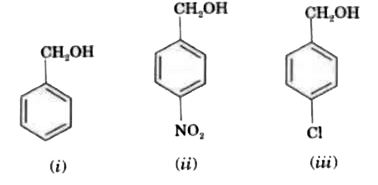Mark the correct increasing order of reactivity of the following compounds with HBr/HCl.i a < b < cii b < a < ciii b < c < aiv c < b < a
iii b < c < a
Related Solutions
Mark the correct increasing order of reactivity of the following compounds with HBr/HCl.

View SolutionMark the correct increasing order of reactivity of the following compounds with .

View SolutionMark the correct increasing order of reactivity of the following compounds with HBr/HCl.

View SolutionMark the correct increasing order of reactivity of the following compounds with HBr/HCl.

View SolutionMark the correct increasing order of reactivity of the following compounds with HBr/HCI.

View SolutionMark the correct increasing order of reactivity of the following compounds with HBr/HCl.

View SolutionMark the correct increasing order of reactivity of the following compounds with .

View SolutionArrange the following compounds in their increasing pK_(b) order: (a). (b). (c). (d).
View SolutionMake the correct increasing order of reactivity of following compounds with HBr//HCl
View SolutionArrange the following compounds in the increasing order of their reactivity in nucleophilic addition reaction
A) Acetophenone B) Benzaldehyde C) Formaldehyde D) Acetone
View SolutionFind correct chemical reactivity order for the (a) ethane (b) ethee and (c) ethyne
View SolutionOn the basis of given reactions,the correct order of increasing oxidising of A,B,C & D is. , (b) , (c) , (d)
View SolutionOn the basis of given reactions,the correct order of increasing oxidising of A,B,C & D is. [ (a) A^- + B rarr A + B^- , (b) C + D^- rarr no reaction , (c) C^- + B rarr no reaction , (d) D + A^- rarr D^- + A]
View SolutionIf ={a,b,c} and R={(a,a),(a,b),(b,c),(b,b),(c,c),(c,a)} is a binary relation on A, then one of the following is correct?
View SolutionMark the correct order of increasing reactivity.
View SolutionMark the correct order of increasing reactivity
View SolutionMark the correct order of increasing reactivity.
View SolutionIf are numbers in increasing order and are numbers in decreasing order , then which one of the following sequences need neither be in a decreasing nor in an increasing order? E, C, D (b) E, B , C (c) D, B, A (d) A, E ,C
View SolutionThere are 3 unknown metals-A ,B and C,C displaces B from its oxide while with oxide of A, there is no reaction. Give the reactivity order of A, B and C.
View SolutionThe order of decreasing reactivity towards electrophilic reagent, for the following compounds : (a) Benzene (b) Toluene (c) Chlorobenzene (d) Phenol Would be :
View Solution